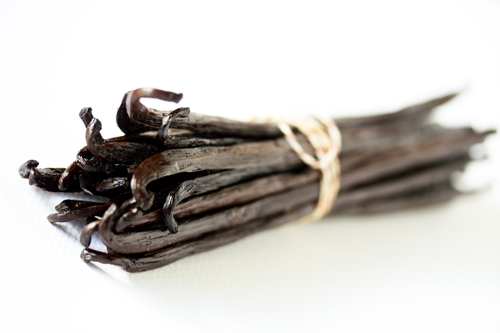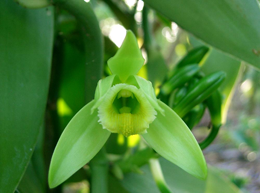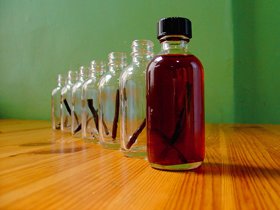New multipurpose flavour ingredients
Vanilla is the number one flavour with respect to its consumption, popularity and wide range of applications. Vanilla can be found in desserts, puddings, yoghurt and ice creams, in candies and bakeries. It is used in whisky and liqueurs, in milk, soy milk, rice milk and cola beverages, in seasonings, spice products and even in tobacco. It combines especially well with chocolate, butter and fruit flavours as a background enhancer. To conceal unpleasant tastes and odours, vanilla is often found in cosmetics such as lipsticks and mouthcare products, as well as in pharmaceuticals. It is even used in perfumery along with heliotropic fragrances and heavy oriental notes. The almost universal application explains the rule of thumb in the flavour and fragrance industries a trace of vanilla can’t hurt.

Vanilla exists in a variety of different forms: the true natural extracts from vanilla beans; the quasinatural vanillin derived from biotechnological processes, with vanillin being the metabolism product of special microbes; the synthetic nature, identical vanillin, produced by different processes mainly ex-lignin and ex-guajacol; and last but not least the artificial flavour composition a blend that also includes substitutes such as ethyl vanillin which cannot be found in nature. All these products exhibit large differences in aroma profile and quality, as well as in price level and application.
The following discussion refers to vanilla extracts only, with their organoleptic impression of vanillin rounded out by a large number of minor constituents, resulting in the unique, inimitable natural vanilla flavour profile.
RAW MATERIAL
Vanilla beans are derived from a species of wild orchid, Vanilla planifolia Andr., a climbing vine which was indigenous to Mexico.
 Meanwhile, vanilla production can be found in all tropical climates within 200 North and South of the equator, yet only a few countries produce vanilla beans on an industrial scale, because production is a tedious process which demands complex know how to achieve high-grade qualities. This applies not only to the cultivation but also to the drying, fermenting and curing processes during which the flavour is achieved.
Meanwhile, vanilla production can be found in all tropical climates within 200 North and South of the equator, yet only a few countries produce vanilla beans on an industrial scale, because production is a tedious process which demands complex know how to achieve high-grade qualities. This applies not only to the cultivation but also to the drying, fermenting and curing processes during which the flavour is achieved.
Today Mexico has reduced its production, and the main growing areas of vanilla beans are the Indian Ocean countries of Madagascar, Comoros, Reunion, Seychelles on the one hand, and more recently the Indonesian islands, especially of Java and Bali, on the other. Different varieties are the Tahitian (V. tahitensis), Guadeloupe and Martinique (V. pompona ‘Vanillons’) vanilla products and will not be considered in this article.
EXTRACTION
High quality vanilla beans have a moisture content of 18-25% and a vanillin content of 1.8-2.4% (calculated on dry matter) combined with more than 100 minor trace components that make up the complex and extremely rich vanilla aroma. Since distillation methods fail to remove the vanilla flavour from the cured beans, various extraction procedures have been developed for aroma separation, which are more or less successful in representing the total rich and typical flavour of the vanilla beans.
A standard procedure is the percolation of the ground beans with an ethanol/water mixture of 35-50%. The extract concentration is given by ‘single fold’, a commercial term especially used in the United States. Single fold means a product containing the extract of 100g beans in 1 Litre of solvent.
This percolation technique, however, is limited to a four to five-fold concentration. For more concentrated products it is necessary to distil off the solvent in part or even completely, giving a 20-30 fold product at the most, i.e. an extract to raw material ratio of 1 to 2-3. Of course, during the stripping of the solvent there are some losses of volatile components as well as the formation of other flavour nuances. These occur through chemical reactions such as hydrolysis and transesterification, giving the intimate flavour impression of the alcoholic type of vanilla extracts.
One of the most recent extraction technologies already well established in the vanilla field is supercritical fluid extraction (SFE), a high pressure process using natural carbon dioxide (CO2) as solvent. SFE extracts are virtually free of solvent, composed by 100% of the plant’s ingredients and produced under gentle conditions that can’t damage or adulterate sensitive plant ingredients. Since carbon dioxide is a real lipophilic solvent, the extraction is much more selective towards the flavour ingredients, leaving back colours, sugars and other polar components of the alcoholic process which don’t contribute to the vanilla flavour impression. In addition the CO2 process works without any environmental pollution.
CO2 EXTRACTS
Two different product types are simultaneously obtained during the CO2 extraction of vanilla beans. One, ‘Vanilla 12’ with a vanillin content of 12%, is a pasty liquid composed of vanilla lipids rich in top notes and saturated with vanillin, the yield being 5%. The second product ‘Vanilla 95’ with 95% of vanillin, is made up of the bean’s surplus vanillin and recovered as a second phase, with 1% yield during CO2 extraction. Vanilla 95 is crystalline and still has a very strong impact of vanilla beans, in contrast to artificial vanillin which is completely different in character. A mixture of both extracts in the ratio of their yields gives rise to a third product ‘Vanilla 25’, with 25% of vanillin content that represents the complete CO2 extract of vanilla beans.
All three CO2 vanilla products reflect the well balanced natural vanilla flavour. They are concentrated extracts with a very low threshold of flavour recognition. A dosage of 30-120 ppm in the end product, such as ice cream or soy milk, is sufficient to develop the full pleasant smooth and creamy sweet aroma of the cured vanilla beans.
The preferred type of CO2 extract depends on the application. Vanilla 12 is more lipophilic in nature, whereas Vanilla 95 exhibits better solubilities in alcoholic and water based products. Vanilla 25 takes an intermediate position in this regard. The strength of aroma does not directly correlate to the vanillin content.
ANALYTICAL COMPOSITION
The three CO2 vanilla extracts have been analysed by HPLC and compared to a one-fold alcoholic extract prepared according to the standard method. Table 1 gives the concentration of the main components, vanillin (V), p-hydroxy-benzaldehyde (p-HBA), vanillic acid (VA) and p-hydroxybenzoic acid (p-HBAc) in these extracts.
It is obvious from Table 1 that different amounts of these constituents can be found in different types of extract; but also that their ratio changes with type of extract according to Table 2.
| % | V | p-HBA | VA | p-HBAc |
| CO2 Vanilla 95 | 95 | |||
| CO2 Vanilla 25 | 25 | |||
| CO2 Vanilla 12 | 12 | |||
| One-fold Vanilla | 0,2 |
This means that the conventional ratio numbers vanillin/p-hydroxybenzaldehyde or vanillin/vanillic acid, which are often used to define the quality and purity of hydroalcoholic extracts, are no longer applicable for CO2 extracts are not caused by the addition of vanillin, but can be explained if the CO2 extracted vanilla beans are investigated with respect to residual vanillian, p-hydroxybenzaldehyde and vanillic acid, which in this sequence are characterised by increasing polarity. As a result it can be demonstrated that the extraction efficiency of CO2 as lipophilic solvent decreases accordingly for these components.
It must be emphasied that this situation does not interfere with the flavour quality, since p-hydroxybenzaldehyde (slight aromatic odour) and vanillic acid (odourless) are not very important for the character of vanilla extracts.
SUMMARY
CO2 vanilla extracts are concentrated products about 200 times more powerful than the standard single-fold US vanilla extract. They give an excellent, long lasting flavour impression in many kinds of application. They are preferred to alcoholic products, especially in baby food, dairy and light food products. On the other hand they also combine well with conventional vanilla extracts by modifying, improving or boosting their organoleptic properties. They are thus new and powerful tools for flavourists and food technologists to create premium food qualities and they are already used by several flavour houses and food companies worldwide.

